Bluesky is quickly becoming one of the most talked-about alternatives to X (formerly Twitter) — but what exactly is it, and why is it making waves?
Bluesky is a social media platform that was launched as an invite-only app in February 2023 and made available to the general public in February 2024. It joins a collection of other Twitter competitors like Mastodon and Threads, each with its own take on micro-blogging.
More recently, Bluesky made headlines as a wave of public figures joined. Promising a decentralized, user-first experience that gives people more control, the platform is seeing now impressive growth that’s worth paying attention to. Let’s take a look at what Bluesky is, how it functions, and whether it’s a viable alternative to Twitter.
What Is Bluesky?
Bluesky began as an internal Twitter project in 2019, funded by the company with the goal of building a decentralized standard for social media. By late 2021, Bluesky became an independent Public Benefit Corporation, and in late 2022 — after Elon Musk took over Twitter — its service agreement with Twitter was officially severed, setting Bluesky on its own path.
So what makes Bluesky different? The company has a great explainer comic that compares social media to islands.
We can think of traditional social media platforms as isolated islands. Each time you join a new platform — whether it’s Twitter, TikTok, or Facebook — you have to start from scratch: new account, new network, new settings, new content. Worse, your data is owned by the company running that platform, and there’s no way to take it with you if you leave. After all, these platforms don’t communicate with each other; they compete.
The idea behind Bluesky was to break down these barriers by creating an “open social protocol for public conversation.” The company developed the AT Protocol, “an open source toolbox for building social apps that can all talk to each other.” This means you can create an account that moves with you from app to app. Customize your experience on one, switch platforms if you want, and take all your content, network, and settings with you. No more starting over!
Built on the AT Protocol is Bluesky, the microblogging app. This is the platform that emulates classic Twitter — but with a few differences.
How Bluesky Works
At first glance, Bluesky feels a lot like the Twitter we all know. You follow people, scroll through short-form content, and engage in conversations. What sets it apart, though, is how much control users have over their experience. Let’s explore some notable elements of Bluesky.
Feeds: Choose What You See
Bluesky offers a basic reverse-chronological feed showing posts from people you follow — just like the early days of social media. There’s also a Discover feed, where Bluesky’s algorithm suggests posts it thinks you’ll like.

What Bluesky uniquely offers, though, is custom Feeds. Anyone can create and share a feed focused on a specific topic, content type, or community. Want a timeline full of cat memes? Breaking news? Niche industry updates? You can build (or follow) a feed for it and easily switch between them.
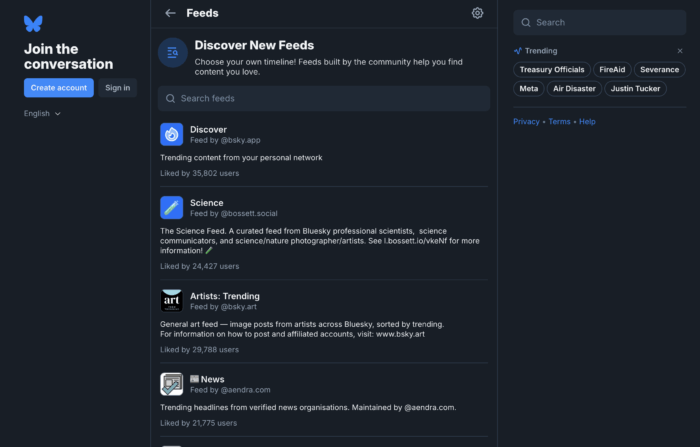
Lists & Starter Packs
Bluesky’s Lists lets you organize accounts into groups, whether it’s favorite creators, industry experts, or even a list of people you prefer to block. Lists can be private or public, giving users more control over content curation.
For new users, there are also Starter Packs to help you hit the ground running. These curated collections recommend up to 150 users and three custom feeds to follow, making it easy to build your timeline.
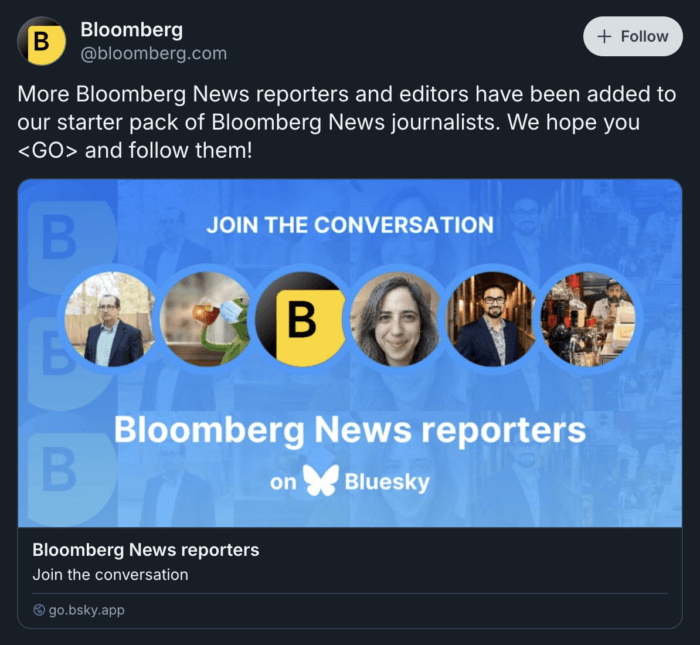
High Level of Customization
Bluesky gives users control over how replies, threads, reposts, and quotes appear in their timeline, allowing you to tailor your experience. Content moderation is also in your hands. You can set up custom keyword filters and control who interacts with you.
Profiles & Verification
Profiles come with the usual features — profile picture, banner image, and bio — but there’s no verification checkmark like on X. Instead, Bluesky allows users to verify their identity by linking their handle to a web domain, which works as a built-in authenticity check since only domain owners can set it up. For example, Netflix uses @netflix.com.
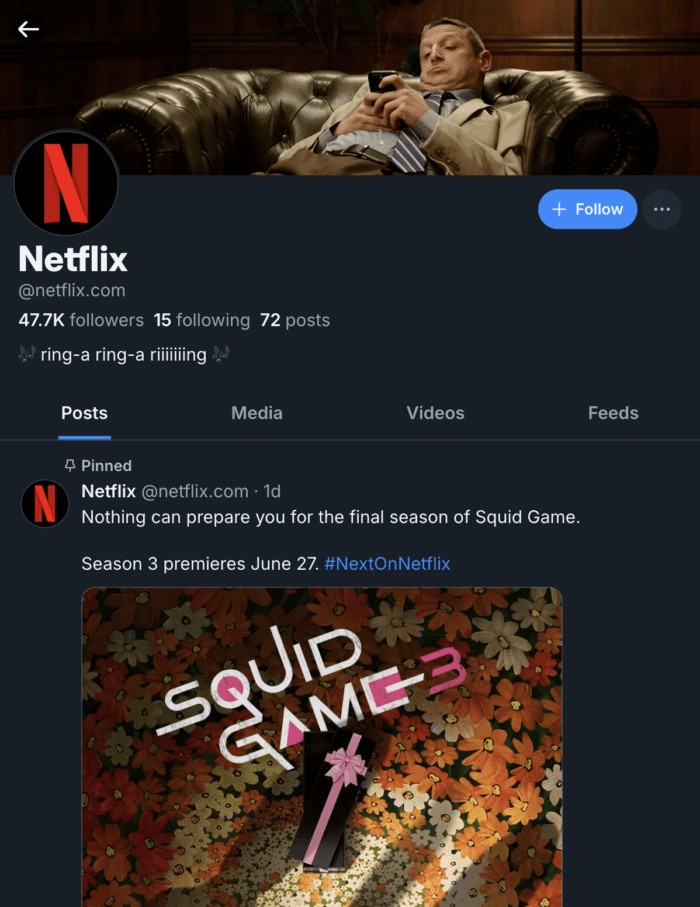
Bluesky vs. X (formerly Twitter): Key Differences
Since we’ve covered a lot of ground so far, here’s a quick summary of the differences between Bluesky and X (Twitter):
Protocol vs. Platform
- Bluesky: Built on the AT Protocol, Bluesky is a decentralized platform, meaning users have ownership of their accounts and data. If another social media app adopts the same protocol, you can switch platforms easily.
- X: A centralized platform controlled entirely by a single company. If Twitter shuts down, you lose everything. There’s no way to transfer your profile elsewhere.
Algorithm & Feeds
- Bluesky: Offers multiple feed options, including a reverse chronological timeline of people you follow, a discovery feed with recommended content, and custom feeds that anyone can create. Users can easily switch between feeds and tailor their experience.
- X: Offers two feed options: a reverse chronological timeline of people you follow and a “For you” timeline that uses a proprietary algorithm to decide what content you see. The algorithm is opaque, meaning users don’t have much control over it.
Verification
- Bluesky: No checkmark verification system, but users can verify themselves by linking their profile to a domain name. Since only the domain owner can set this up, it works as a built-in way to confirm identity.
- X: Moved to a pay-for-verification model with X Premium. Anyone willing to pay a monthly fee can get a blue checkmark. Gold checkmarks indicate an official organization. Gray checkmarks indicate a government/multilateral organization or official.
Monetization
- Bluesky: No ads or paid subscriptions. It’s funded through grants, investors, and public funding. The team has mentioned plans for future monetization, but nothing has been confirmed yet.
- X: Makes money through “the sale of advertising services, the sale of data licensing and other services, and the Premium subscription.”
Analytics
- Bluesky: Doesn’t offer built-in analytics, but because the platform is open-source, third-party tools have emerged to provide insights.
- X: X does offer native analytics, but only to X Premium subscribers. Professional accounts are also supposed to get a performance dashboard, but the rollout has been slow and not everyone has access.
Who’s On Bluesky?
So, who exactly is flocking to Bluesky? As of January 2025, the platform has over 30 million users. Many of the users, from actress Gabrielle Union to entrepreneur Mark Cuban, seem to have migrated from X (Twitter), often in response to unpopular updates.
For instance, you can see in Rival IQ’s social analytics dashboard that Bluesky saw a massive jump in Twitter engagement in October 2024. This coincides with Twitter announcing that the “Block” feature would change: If your Twitter account is set to public, any user you block will now be able to see your content. They just won’t be able to engage with it directly.
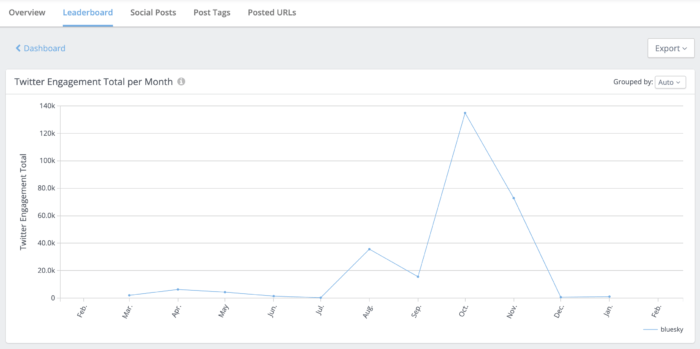
This X update was highly controversial, with users concerned about it enabling harassment, stalking, and other dangerous behaviors. In response, Bluesky cheekily highlighted how it approached online safety.
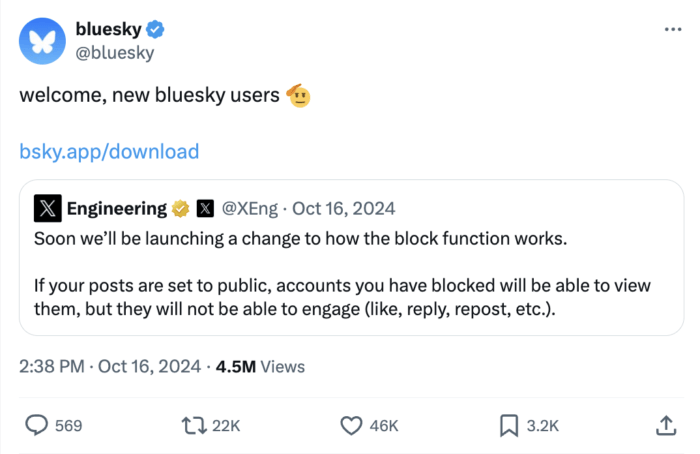

That first tweet ended up being Bluesky’s most engaging post of 2024, earning a 23% engagement rate by follower!
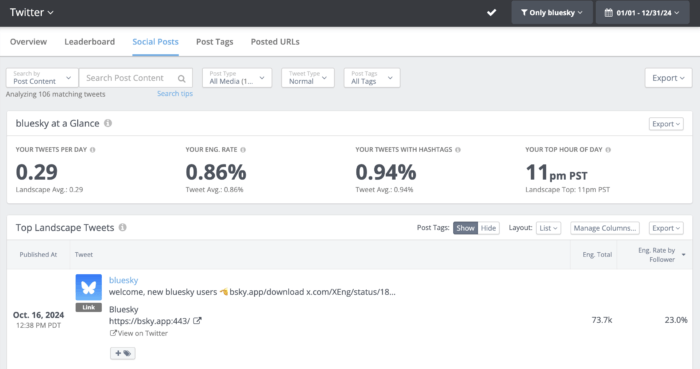
Soon after, Bluesky signups skyrocketed, with another uptick occurring after the U.S. presidential election. The app celebrated 1,000,000 people joining in a single day in November 2024 and, according to a live tracker, Bluesky is currently growing at a rate of one new user per second.

Of course, compared to X’s estimated 335 million monthly active users and Meta’s Threads 320 million, Bluesky is still a relatively small player in the social media arena. But it’s attracting a diverse and influential crowd of journalists, artists, political leaders, and more. Even brands are making their way over, testing the waters of this decentralized space. It’s quickly becoming a home for thought leaders, creatives, and people looking for a place to make meaningful digital connections.
The Wrap Up
In short, Bluesky is offering a refreshed take on social media, combining the familiar feel of old-school Twitter with decentralization and greater user control. With custom feeds, an open protocol, and a growing number of thought leaders making the switch, it’s an exciting platform — but it also has a long way to go if it wants to catch up to the sheer size of X or Threads. Either way, Bluesky is changing the conversation around what social media can be. We’ll definitely be keeping an eye on it. 👀
